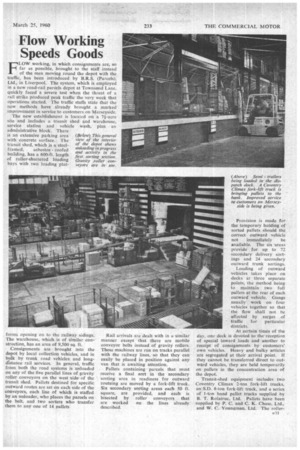Flow Working Speeds Goods
Page 65

Page 66

If you've noticed an error in this article please click here to report it so we can fix it.
FLOW working, in which consignments are, so far as possible, brought to the staff instead of the men moving round the depot with the traffic, has been introduced by B.R.S. (Parcels), Ltd., in Liverpool. The system, which is employed in a new road-rail parcels depot at Townsend Lane, quickly faced a severe test when the threat of a rail strike produced peak traffic the very week that operations started. The traffic staffs state that the new methods have already brought a marked improvement in service to customers on Merseyside.
framed, asbestos roofed building, has a 600-ft. length of roller-shuttered loading bays with two loading plat forms opening on to the railway sidings. The warehouse, which is of similar construction, has an area of 9,500 sq. ft.
Consignments are brought into the depot by local collection vehicles, and in bulk by trunk road vehicles and longdistance rail services. In general, traffic from both the road systems is unloaded on any of the five parallel lines of gravity roller conveyors on the west side of the transit shed. Pallets destined for specific outward routes are set on each side of the conveyors, each line of which is staffed by an unloader, who places the parcels on the belt, and two sorters who transfer them to any one of 14 pallets Rail arrivals are dealt with in a similar manner except that there are mobile conveyor belts instead of gravity rollers. These machines are run on tracks parallel with the railway lines, so that they can easily be placed in position against any van that is awaiting attention.
Pallets containing parcels that must receive a final sort in the secondary sorting area in readiness for outward routeing are moved by a fork-lift truck. Six secondary sorting areas each 50 ft. square, are provided, and each is bisected by roller conveyors that are worked on the lines already' described.
Provision is made for the temporary holding of sorted pallets should the correct outward vehicle not immediately be available. The six areas provide for up to 72 secondary delivery sortings and 24 secondary outward trunk sortings.
Loading of outward vehicles takes place on decks at three separate points, the method being to maintain two full pallets at the rear of each
• outward vehicle. Gangs usually— work on four vehicles together so that the flow shall not be affected by surges of traffic for particular districts.
At certain times of the day, one deck is devoted to the-reception of special inward loads and another to receipt of consignments by customers' own vehicles. Heavy and bulky articles are segregated at their arrival point. If they cannot be transferred direct to outward vehicles, they are held temporarily on pallets in the concentration area of the depot.
Transit-shed equipment includes two Coventry Climax 2-ton fork-lift trucks. an S.D. 8-ton fork-lift truck, and a series of 1-ton hand pallet trucks supplied by B. T. Rolatruc, Ltd. Pallets have been supplied by P. C. and C. K. Chase, Ltd., and W. C Youngman, Ltd. The roller conveyor equipment is the product of Rownsons (Conveyors), Ltd.
In the warehouse, where there are narrow aisles, Yale electric pallet stackers are used in preference to forklift trucks. Part of this department is at present used for sorting and holding goods on hand, and for the preparation of import traffic that is received in bulk for delivery in accordance with owners' instructions.
Both the office block and service station are steel-framed, and the station has a floor area of 11,000 sq. ft. Collapsible folding steel doors are provided, and in the main building are five inspection pits. The sections include tyre, oil and general stores, battery room and locker room. A separate fuelling island has a central issuing cabin with remote controls for oil fuel, lubricant and petroldispensing points.
The underfloor method of heating has been chosen for the three-floor office block, which has a total area of 11,250 sq. ft. There are two canteens and a modern kitchen.
The depot will be officially opened next Wednesday.




















































































































